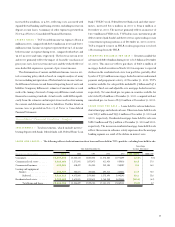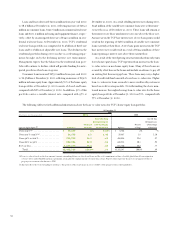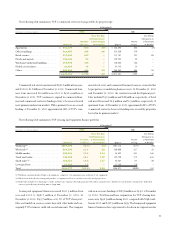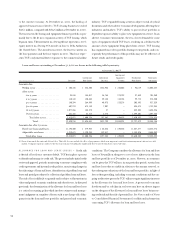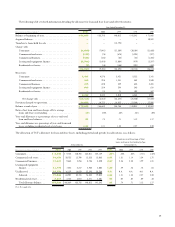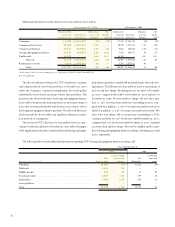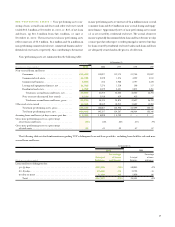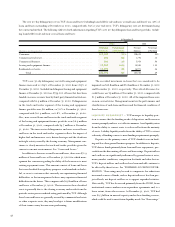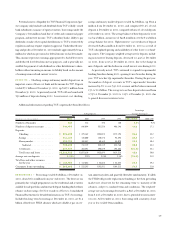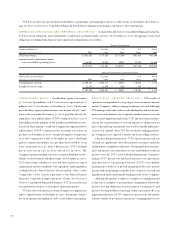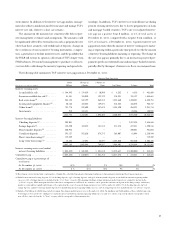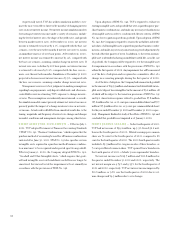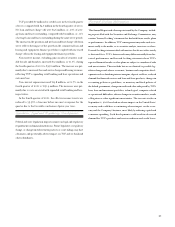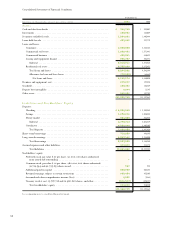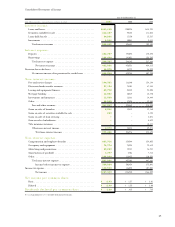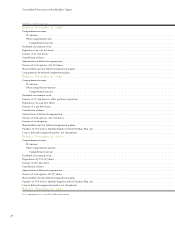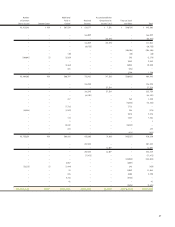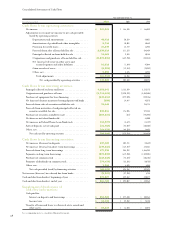TCF Bank 2001 Annual Report Download - page 40
Download and view the complete annual report
Please find page 40 of the 2001 TCF Bank annual report below. You can navigate through the pages in the report by either clicking on the pages listed below, or by using the keyword search tool below to find specific information within the annual report.
38
TCF’s over 30-day delinquency on total leasing and equipment
finance increased to 1.84% at December 31, 2001 from 1.83% at
December 31, 2000. Included in delinquent leasing and equipment
finance at December 31, 2001 are $754,000 of leases that have been
funded on a non-recourse basis by third-party financial institutions,
compared with $2.4 million at December 31, 2000. Delinquencies
in the truck and trailer segment of the leasing and equipment
finance portfolio were $11 million, or 7.6% at December 31, 2001,
compared with $10.4 million, or 6.8%, at December 31, 2000.
Also, non-accrual loans and leases in the truck and trailer segment
of the leasing and equipment finance portfolio were $6.9 million
at December 31, 2001, compared with $4.7 million at December
31, 2000. The increase in delinquencies and non-accrual loans
and leases in the truck and trailer segment reflects the impact of
higher fuel and insurance costs, driver shortages and the slowdown
in freight activity caused by the slowing economy. Management con-
tinues to closely monitor the truck and trailer portfolio given the
current economic environment. See “Loans and Leases.”
In addition to the non-accrual loans and leases, there were $71.9
million of loans and leases at December 31, 2001 for which man-
agement has concerns regarding the ability of the borrowers to meet
existing repayment terms. This amount consists of loans and leases
that were classified for regulatory purposes as substandard or doubt-
ful, or were to customers that currently are experiencing financial
difficulties or that management believes may experience financial
difficulties in the future. This compares with $19.8 million of loans
and leases at December 31, 2000. The increase in these classified
assets is generally due to the slowing economy and results from the
periodic review process and risk rating performed by TCF. Although
these loans and leases are generally secured by commercial real estate
or other corporate assets, they may be subject to future modifications
of their terms or may become non-performing.
The recorded investment in loans that are considered to be
impaired was $18.8 million and $6.8 million at December 31, 2001
and December 31, 2000, respectively. The related allowance for
credit losses was $5 million at December 31, 2001, compared with
$1.3 million at December 31, 2000. All of the impaired loans were
on non-accrual status. Management monitors the performance and
classification of such loans and leases and the financial condition of
these borrowers.
LIQUIDITY MANAGEMENT – TCF manages its liquidity posi-
tion to ensure that the funding needs of depositors and borrowers
are met promptly and in a cost-effective manner. Asset liquidity arises
from the ability to convert assets to cash as well as from the maturity
of assets. Liability liquidity results from the ability of TCF to attract
a diversity of funding sources to meet funding requirements promptly.
Deposits are the primary source of TCF’s funds for use in lend-
ing and for other general business purposes. In addition to deposits,
TCF derives funds primarily from loan and lease repayments, pro-
ceeds from the discounting of leases and borrowings. Deposit inflows
and outflows are significantly influenced by general interest rates,
money market conditions, competition for funds and other factors.
TCF’s deposit inflows and outflows have been and will continue to
be affected by these factors. See “FORWARD-LOOKING INFOR-
MATION.” Borrowings may be used to compensate for reductions
in normal sources of funds, such as deposit inflows at less than pro-
jected levels, net deposit outflows or to support expanded activities.
Historically, TCF has borrowed primarily from the FHLB, from
institutional sources under reverse repurchase agreements and, to a
lesser extent, from other sources. At December 31, 2001, TCF had
over $2.3 billion in unused capacity under these funding sources,
which could be used to meet future liquidity needs. See “Borrowings.”
The over 30-day delinquency rate on TCF’s loans and leases (excluding loans held for sale and non-accrual loans and leases) was .57% of
loans and leases outstanding at December 31, 2001, compared with .69% at year-end 2000. TCF’s delinquency rates are determined using
the contractual method. The following table sets forth information regarding TCF’s over 30-day delinquent loan and lease portfolio, exclud-
ing loans held for sale and non-accrual loans and leases:
At December 31,
2001 2000
2
Principal Percentage Principal Percentage
(Dollars in thousands) Balances of Portfolio Balances of Portfolio
Consumer . . . . . . . . . . . . . . . . . . . . . . . . . . . . . . . . . . . . . . . . . . . . . $17,939 .72% $20,628 .93%
Commercial real estate. . . . . . . . . . . . . . . . . . . . . . . . . . . . . . . . . . . . . 538 .03 1,793 .13
Commercial business. . . . . . . . . . . . . . . . . . . . . . . . . . . . . . . . . . . . . . 526 .13 3,958 .96
Leasing and equipment finance . . . . . . . . . . . . . . . . . . . . . . . . . . . . . . 17,393 1.84 15,508 1.83
Residential real estate. . . . . . . . . . . . . . . . . . . . . . . . . . . . . . . . . . . . . . 10,377 .38 16,971 .46
Total . . . . . . . . . . . . . . . . . . . . . . . . . . . . . . . . . . . . . . . . . . . . $46,773 .57 $58,858 .69





